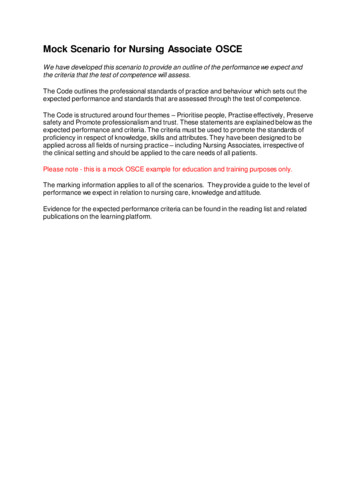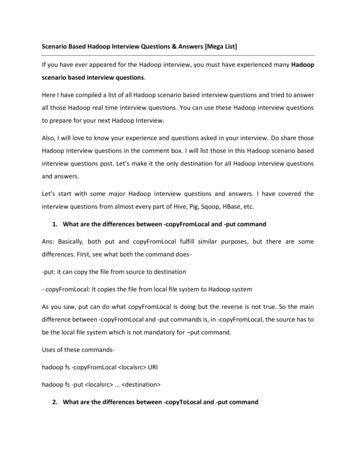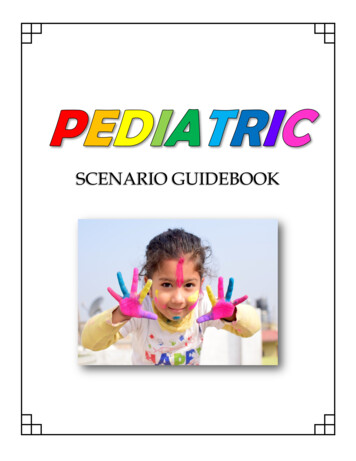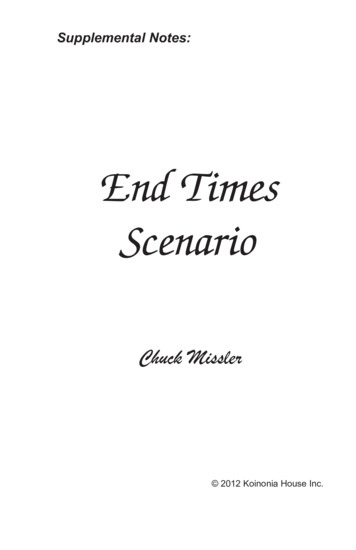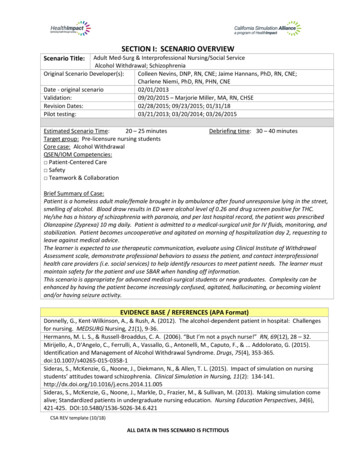
Transcription
Scenario Title:SECTION I: SCENARIO OVERVIEWAdult Med-Surg & Interprofessional Nursing/Social ServiceAlcohol Withdrawal; SchizophreniaOriginal Scenario Developer(s):Colleen Nevins, DNP, RN, CNE; Jaime Hannans, PhD, RN, CNE;Charlene Niemi, PhD, RN, PHN, CNEDate - original scenario02/01/2013Validation:09/20/2015 – Marjorie Miller, MA, RN, CHSERevision Dates:02/28/2015; 09/23/2015; 01/31/18Pilot testing:03/21/2013; 03/20/2014; 03/26/2015Estimated Scenario Time:20 – 25 minutesTarget group: Pre-licensure nursing studentsCore case: Alcohol WithdrawalQSEN/IOM Competencies: Patient-Centered Care Safety Teamwork & CollaborationDebriefing time: 30 – 40 minutesBrief Summary of Case:Patient is a homeless adult male/female brought in by ambulance after found unresponsive lying in the street,smelling of alcohol. Blood draw results in ED were alcohol level of 0.26 and drug screen positive for THC.He/she has a history of schizophrenia with paranoia, and per last hospital record, the patient was prescribedOlanzapine (Zyprexa) 10 mg daily. Patient is admitted to a medical-surgical unit for IV fluids, monitoring, andstabilization. Patient becomes uncooperative and agitated on morning of hospitalization day 2, requesting toleave against medical advice.The learner is expected to use therapeutic communication, evaluate using Clinical Institute of WithdrawalAssessment scale, demonstrate professional behaviors to assess the patient, and contact interprofessionalhealth care providers (i.e. social services) to help identify resources to meet patient needs. The learner mustmaintain safety for the patient and use SBAR when handing off information.This scenario is appropriate for advanced medical-surgical students or new graduates. Complexity can beenhanced by having the patient become increasingly confused, agitated, hallucinating, or becoming violentand/or having seizure activity.EVIDENCE BASE / REFERENCES (APA Format)Donnelly, G., Kent-Wilkinson, A., & Rush, A. (2012). The alcohol-dependent patient in hospital: Challengesfor nursing. MEDSURG Nursing, 21(1), 9-36.Hermanns, M. L. S., & Russell-Broaddus, C. A. (2006). “But I’m not a psych nurse!” RN, 69(12), 28 – 32.Mirijello, A., D'Angelo, C., Ferrulli, A., Vassallo, G., Antonelli, M., Caputo, F., & . Addolorato, G. (2015).Identification and Management of Alcohol Withdrawal Syndrome. Drugs, 75(4), 353-365.doi:10.1007/s40265-015-0358-1Sideras, S., McKenzie, G., Noone, J., Diekmann, N., & Allen, T. L. (2015). Impact of simulation on nursingstudents’ attitudes toward schizophrenia. Clinical Simulation in Nursing, 11(2): 05Sideras, S., McKenzie, G., Noone, J., Markle, D., Frazier, M., & Sullivan, M. (2013). Making simulation comealive; Standardized patients in undergraduate nursing education. Nursing Education Perspectives, 34(6),421-425. DOI:10.5480/1536-5026-34.6.421CSA REV template (10/18)ALL DATA IN THIS SCENARIO IS FICTITIOUS
SECTION II: CURRICULUM INTEGRATIONA. SCENARIO LEARNING OBJECTIVESLearning Outcomes1. Analyze assessment data characteristics of a patient with alcoholism and schizophrenia.2. Utilize the nursing process in prioritizing care for a patient with addictive behaviors and mental illness.3. Provide patient-centered care utilizing principles of safety and minimize risk of error.4. Integrate understanding and skill in collaborative care between multiples disciplines.Specific Learning Objectives1. Apply principles of hand hygiene and infection control.2. Correctly identify patient using two identifiers.3. Utilize assessment technique in gathering relevant patient data.4. Cluster relevant data to identify and prioritize patient problems.5. Perform timely nursing dependent and interdependent interventions to address priority problem(s).6. Evaluate effectiveness of interventions.7. Communicate effectively with the patient and interprofessional personnel.8. Administer medications using principles of safety.Critical Learner Actions1. Demonstrate washing hands, introducing self, and identifying the patient using two identifiers.2. Perform assessment, recognizing signs of increased anxiety/agitation and safety risks.3. Identify signs and symptoms of delirium tremens.4. Utilize Clinical Institute Withdrawal Assessment (CIWA) scale for alcohol intoxication monitoring.5. Employ interdependent nursing intervention by facilitating collaborative care planning in order tointervene appropriately to promote physiological and psychological safety.6. Use therapeutic communication with the patient to assure needs, values, and preferences are understoodand relayed to the health care team.7. Collaborate with social services to develop and validate interventions.8. Administer medications using three checks and six rights to assure safety.9. Hand off communication to health care team members using a standardized tool, e.g., SBAR.B. PRE-SCENARIO LEARNER ACTIVITIESPrerequisite CompetenciesSkills/ AttitudesKnowledge Nursing process General survey and head-to-toe assessment Etiology of alcohol withdrawal Therapeutic and professional communication Pathophysiology of alcoholism andschizophreniaNational Patient Safety Goals Dimensions of patient-centered care Six rights of medication administration Structured communication tool, i.e., SBAR Nursing interventions for alcohol withdrawal andmental health issues, including use of CIWA scaleValue active participation in plan of careValue the perspectives and expertise of all healthteam membersEffective use of technology and standardizedpractices that support safety and qualityCSA REV template (10/18)ALL DATA IN THIS SCENARIO IS FICTITIOUS
SECTION III: SCENARIO SCRIPTA.Case summaryA 33-yr-old male (or female) with a history of alcoholism and schizophrenia, is admitted to the medical-surgicalfloor from the ED the night before last, after being found unresponsive in the street. He/she presented to theED obtunded, and only responsive to painful stimuli, with positive drug and alcohol screening, along with lowmagnesium level. CT of head was WNL. IV fluids were administered, and patient monitoring continued sinceadmission. He/she has been a poor historian about past medical history and drug/alcohol use.The patient is now alert, oriented to name and place, becoming increasingly agitated with notable tremors,pacing, talking to self and uncooperative with care. The patient asks every person who enters the room to signhis/her notebook. He/she continually asks about the location of his/her belongings and his/her dog. Patientbecomes restless and frustrated, expressing a desire to leave the hospital.B. Key contextual detailsC. Scenario CastPatient/ Client RoleTeam LeaderPrimary NurseSecondary NurseSocial WorkerFriendHigh fidelity simulatorMid-level simulatorTask trainerHybrid (Blended simulator) Standardized patientBrief Descriptor(Optional)Oversees and guides care; communicateswith healthcare teamAssessment and evaluation of patientInterventions including medication reviewand administrationAssists with de-escalating patient throughnegotiation; assists patient with availableresources;(optional; may omit this role)CSA REV template (10/18)ALL DATA IN THIS SCENARIO IS FICTITIOUSLStandardized Participant (SP)or Learner (L)LLL or SPSP
Last name:JonesGender:Age: 33Male/FemaleSpiritual Practice:Unknown1. Past historyD.Patient/Client ProfileHt: 178 cm(5’10”)Ethnicity:First name:Wt: 77.27 kg(170 lbs)CaucasianR. KellyCode Status: FullPrimary Language spoken:EnglishR. Kelly Jones is a 33-year-old homeless male/female after found unconscious in the street 2 days ago and wasbrought to ED via ambulance. Blood draw results in ED showed an alcohol level of 0.26 and drug screenpositive for THC. Ct of the head was WNL. He/she has a history of schizophrenia with paranoia, and per lasthospital record, the patient was prescribed Olanzapine (Zyprexa) 10 mg daily. Patient was admitted to amedical-surgical unit for IV fluids, monitoring, and stabilization. The patient has received 2 banana bags.He/she is awake and alert but appears more agitated this morning, asking about his/her belongings and dog.Vital signs are stable.Past medical history: Alcohol abuse; Schizophrenia with paranoia; probable drug use.Primary Medical DiagnosisAlcohol Withdrawal; Schizophrenia2. Review of SystemsCNSAlert, oriented x 2 (person, place)CardiovascularRegular sinus rhythm, no gallops, rubs or murmurs; apical clear S1 and S2; radial andpedal pulses 3PulmonaryLung fields clear crineWNLHeme/CoagNo abnormal bleeding or bruising notedMusculoskeletalWNLIntegumentIntact; tanned face, hands and feet; dirt under nailsDevelopmental HxNormal adultPsychiatric HxDiagnosed with schizophrenia at age 20Social HxHomeless with known alcohol abuse; Denies drug use or smokingAlternative/ Complementary Medicine HxUnknown3. CurrentmedicationsMedication allergies:Food/other ose10 mgRoutePOCSA REV template (10/18)ALL DATA IN THIS SCENARIO IS FICTITIOUSFrequencydaily
4. Laboratory, Diagnostic Study ResultsNa: 144Ca: 9.3Hgb: 13PTABG-pH:VDRL:ETOH: 0.26K: 4.0Mg: 1.9 mEq/LHct: 36.8PTTpaO2:GBS:Albumin: 2.9Cl: 100Phos:1.7 mEq/LPlt: 155,000INR 1.0paCO2:Herpes:AST/SGOT: 38HCO3:Glucose: 118WBC: 5,200Troponin:HCO3/BE:HIV: NegALT/SGPT: 36BUN: 24Cr: 1.4HgA1C:ABO Blood Type: O BNP:SaO2:Cxr:EKGCT of Head: WNLE. Baseline Simulator/Standardized Patient State1. Initial physical appearanceGender: Male/femaleAttire: Hospital gown, posey vest on and untiedAlterations in appearance (moulage): Hair disheveled; Nail beds dirty; Bed sheets messy; area cluttered;belongings in bag on bed. Patient sitting at bedside wearing posey vest over gown/pants/slippers. IDband pinned to posey – ID band present, accurateAllergy band present, accurateID band present, inaccurateAllergy band inaccurateID band absent or not applicableAllergy band absent or N/A2. Initial Vital Signs Monitor display in simulation action room: No monitor displayBP: 144/86HR: 104CVP:PAS:Lungs:Left:Heart:Sounds:Bowel sounds:Monitor on, but no data displayedRR: 20T: 99.2 F. oralPAD:PCWP:Right:Monitor on, standard displaySpO²: 94%CO:Other:3. Initial Intravenous line set up Saline lock #1Site: Left Arm (pulled out; lying on bedside table)IV #1MainPiggybackSite:Fluid type:IV #2MainSite:Fluid type: IV patent (Y/N) - YInitial rate:IV patent (Y/N)Initial rate:IV patent (Y/N)4. Initial Non-invasive monitors set up NIBPECG First lead: Pulse oximeterTemp monitor/type5. Initial Hemodynamic monitors set upA-line Site:Catheter/tubing Patency (Y/N)ECG Second lead:Other:CVC Site:CSA REV template (10/18)ALL DATA IN THIS SCENARIO IS FICTITIOUSPAC Site:
Environment, Equipment, Essential propsRecommend standardized set ups for each commonly simulated environment1. Scenario setting: (example: patient room, home, ED, lobby)Patient room2. Equipment, supplies, monitors(In simulation action room or available in adjacent core storage rooms)Bedpan/ UrinalFoley catheter kitStraight cath. kitIncentive spirometer IV Infusion pumpFeeding pumpPressure bagWall suctionNasogastric tubeETT suction cathetersOral suction cathetersChest tube kitDefibrillatorCode Cart12-lead ECGChest tube equipPCA infusion pumpEpidural pumpCentral line KitDressing equipIV fluid Type:IV fluid additives:Blood products: ABO Type: # of units: Nasal cannulaBVM/Ambu bagFace tentNebulizer tx kit4. Documentation and Order Forms Provider orders Med Admin RecordProgress NotesGraphic recordMed ReconciliatnTransfer orders Nurses’ NotesDx test reportsActual medical record binder5. Medications (to be available in sim action room)# MedicationDosageRoute1 Olanzapine10 mgPoPo2 Chlordiazepoxide 100 mg2 mgPo3 Lorazepam1 mgIV4 LorazepamSimple Face Mask Non-rebreather maskFlowmeters (extra supply) Hx & Physical Anes/PACU recordStanding ordersCode RecordElectronic Medical Record#5MedicationGeodonCSA REV template (10/18)ALL DATA IN THIS SCENARIO IS FICTITIOUSLab ResultsED RecordICU flow sheetPrenatal recordDosage10 mgRouteIM
CASE FLOW / TRIGGERS/ SCENARIO DEVELOPMENT STATESInitiation of Scenario: Charge Nurse Report at 0700: The patient is a homeless adult male or female brought in by ambulance tothe ED 2 days ago after found unresponsive in the street with blood alcohol of 0.26 and testing positive for THC. Admitted tomedical-surgical unit for IV fluids, observation, and monitoring. Patient has a history of schizophrenia with paranoia and prescribedOlanzapine (Zyprexa) 10 mg daily. Patient slept most of the day yesterday but was awake most of the night. Patient seems anxiousthis morning, exhibiting tremors, pacing, and talking to self in room. Vital signs are normal. IV per saline lock. Plan today per ordersis Psychology and Social Service consults. As nurses, you are asked to perform an assessment, continue MD orders, and interveneappropriately.STATE / PATIENT STATUSDESIRED LEARNER ACTIONS & TRIGGERS TO MOVE TO NEXT STATELearner ActionsDebriefing Points:BaselineOperatorPatient sitting at side of bedwearing posey vest over gown,wearing pants and slippers.Hair is disheveled and nailsdirty. ID band pinned to posey– patient refuses anythingaround wrists.Patient agitated, constantlysmacking lips; dialing phone.Patient tremulous; frequentlypacing. Patient demands allpersonnel “sign” his/her smallnotebook before starting anyprocedures.Saline lock pulled out and onbedside table along withrestraints.N/A – use of standardizedpatient; vital signsverbalized by operator orpre-set electronically, e.g.,iPad, monitorInitial vital signs:BP: 144/86HR: 104 regular rhythmRR: 20T: 99.2 F orallySpO2: 94%, room airTriggers:Learner performs actionswithin 10 - 15 minutes1. Enter room, wash hands, andintroduce self & role.2. Identify the patient using 2identifiers (name, DOB).3. Engages patient in plan of care,calmly explaining need forassessment and morningmedications.4. Assess Vital Signs5. Performs neuro, card
schizophrenia Nursing interventions for alcohol withdrawal and mental health issues, including use of CIWA scale National Patient Safety Goals Value active participation in plan of care Dimensions of patient-centered care Value the perspectives and expertise of all health team members Six rights of medication administration Effective use of technology and standardized practices that support .
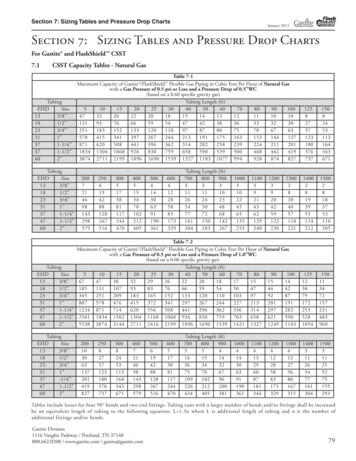


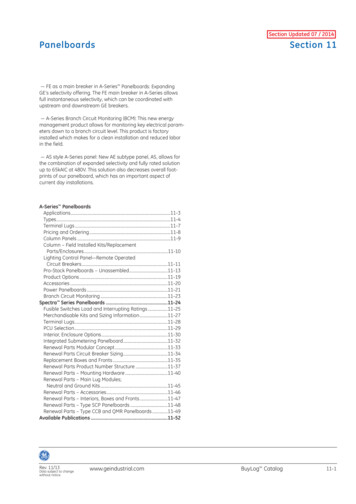

![Informatica Interview Questions and Answers [Scenario-Based]](/img/2/informatica-interview-questions-and-answers-scenario-based-1.jpg)
